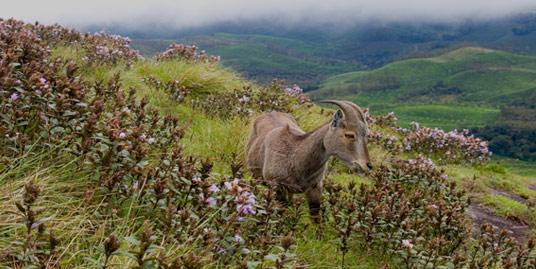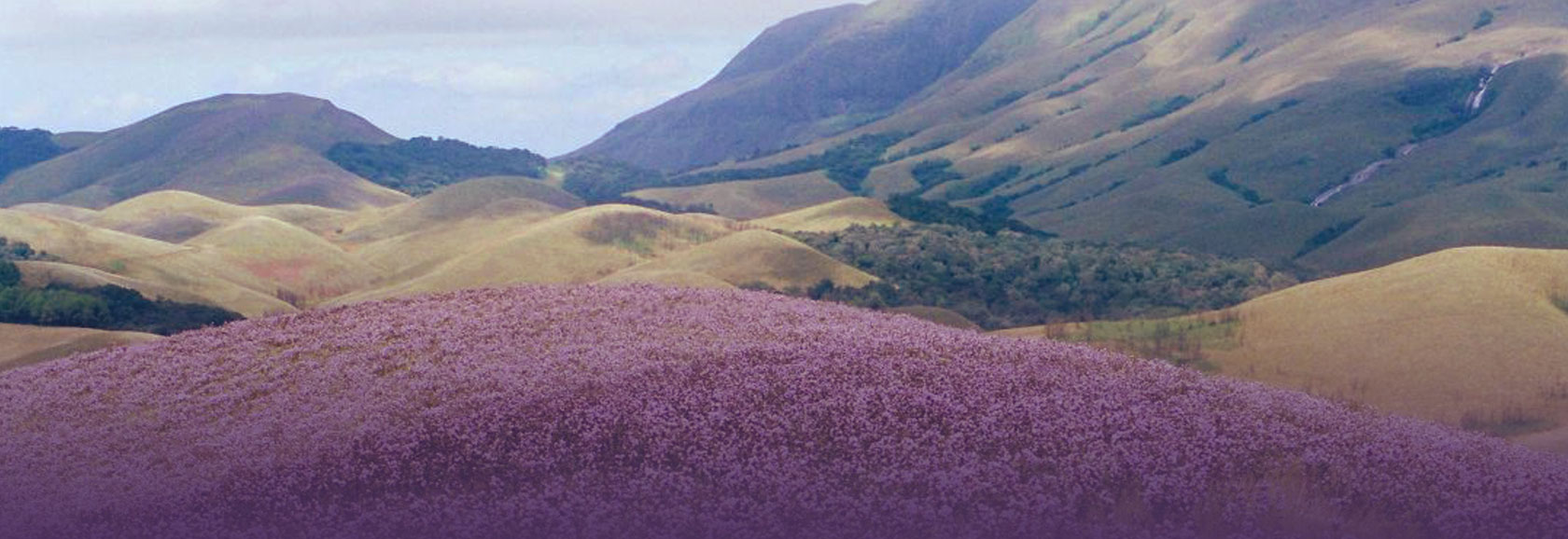

Neelakurinji – the bloom of a unique ecosystem
The bloom makes the mountains blue; We make the landscape brown?
-E Kunhikrishnan


The bloom makes the mountains blue; We make the landscape brown?
-E Kunhikrishnan

The first European settlers in Nilgiris recorded the flowering of the Strobilanthes kunthianus in the year 1826. Robinson M. E. published an article in 1935 in the Journal of Bombay Natural History Society on the gregarious flowering of neelakurinji in 1934. In his paper, he mentioned the gregarious flowering of Strobilanthes kunthianus in Nilgiris once every 12 years, from 1838 to 1934. He notes, “Records of its appearance in 1898 and 1886 have been made by various observers and Mr. Cockburn of Kotagiri, of Nilgiris has given me a remarkable record of its flowering during a hundred years. His grandfather was one of the first European settlers in Nilgiris in 1826, and his aunt first saw Strobilanthes in flowers in 1838 when she was a child of nine; and saw and recorded Strobilanthes in full flower in 1850, 1862, 1874, 1886, 1898, 1910 and 1922.” Robinson made remarks on the 1934 flowering in the Pulneys and Anamalais also. “There were acres of blue flowers in Pulney Hills from the beginning of July until December. On the Nilgiris it did not appear in full flower until August, and in October a hillside above Wellington was blue and much could be still found round Pykara and Kothagiri. On the Anamalais it appeared only in October and covered the grass hills there with sheets of bloom.” Another interesting observation by European naturalists was the gregarious flowering of Strobilanthes attracting large swarms of bees in the vicinity. Each flower secretes honey in a small disc below the ovary, so that immense quantities of honey becomes available, attracting the rock bee (Apis dorsata) and the common Indian honey bee (Apis indica). Robinson writes, “In 1922 as many as 28 bee hives were found hanging from one eucalyptus tree and 32 were counted on an overhanging rock; while swarms took place on the verandah of a college building in Shembaganur.” J.S. Gamble in his paper, ‘The Nilgiri Strobilanthes ‘, published in 1888 in the journal, Indian Forester, mentions about the species and periodicity of the flowering of some species of Strobilanthes in the Nilgiris.
In the Munnar region in Anamalais, there is a population of Strobilathes kunthianus showing an alternate flowering cycle of 12 years. The flowering of this population of neelakurinji is mainly in the Mattupetty - Kannimala region. The gregarious blooming in this distinct population were in the years 1990, 2002 and 2014. Reports of blooming of neelakurinji in years, not in synchronisation with the major bloom had created some confusion in 1990. Some naturalists expressed doubt about the taxonomic identity of this population. Later it was understood that these are distinct populations of S. kunthianus keeping an alternate cycle. The next blooming in Mattupetty region will be in the year 2026. Apart from these, every year there used to be a sporadic flowering of certain neelakurinji plants here and there in the grasslands of Munnar.
In the sholas some of the cholakurinjis like Strobilanthes homotropus, S. gracilis and S. luridus grow up to 8 meters. Strobilanthes homotropus flowered in the Sispara Ghat in the Nilgiris (towards the upper reaches of Silent Valley) in 1834. The author of this article has seen and photographed the flowering of many cholakurinji species having a flowering periodicity of ten years in 1988, 1998 and 2008 in the Anamalais, especially in the Eravikulam National Park and surroundings. The flowering occurred mainly in the months of September and October. S. homotropus, S. gracilis, S. foliosus, S. pulneyensis, S. luridus, S zenkerianus and S. urceolaris were in full bloom in the sholas. The S. urceolaris were seen along the shola edges in the open and among the bushes along the stream sides.
Another very important species that deserves a special mention here is Strobilanthes andersonii which was found and photographed in a few localities in the past three seasons mentioned. Gamble in his Flora mentions it as present in the Anamalais. A large shrub may reach upto 20 feet and with pale blue large flowers in strobilate spikes. In the monograph, Strobilanthes in Peninsular India, published by Botanical Survey of India in 2006, there is mention of only a single collection of plants by Richard Henry Beddome, which he published in 1864. Since then there was no collection and the BSI was anxious that it might have become extinct. Fortunately, it is not extinct but only a few plants remain that propagate in a very narrow geographical range. The next flowering of all these species mentioned, having a flowering periodicity of 10 years is going to be in 2018.
As per the records of Gamble, “Strobilanthes amabilis was in beautiful large panicles of pink bells in the sholas on the hillside above Sisspara in the Nilgiris in 1883”. Gamble considers Strobilanthes violaceous probably the most beautiful of all and he could find it only in one shola near Bangi Tappal in the Nilgiris. The author of this article was lucky enough to photograph S. amabilis and S.violaceous in November in 2014 in Bangi Tappal, probably in the same shola mentioned by Gamble. S. foliosus and S. perrottetianus also were in bloom. Strobilanthes amabilis flowered in the sholas on the Chembra peak in Wayanad in the same season. Strobilanthes wightianus is another common species in the grassy downs of the Nilgiris and Robinson mentions its flowering in abundance in the year 1934. The plants can easily be recognised with a very rough and hairy shrub, 6 to 8 feet high at the edges of sholas and short and compact, less than one meter, on the open hillsides. Sporadic flowering of this species can be seen almost every year in the Nilgiris. During this author’s expedition in the Nilgiris in November 2014, many plants in the meadows at Bangi Tappal were in flowers. Strobilanthes sessilis and S. reticulatus were in flowers in 2009 along the grassy slopes of Thadiyandamol hills in Coorg. S. lanatus is one of the species which is confined to the highest reaches in the Sisspara Ghat in the Nilgiris and Vellarimala. Strobilanthes inegrifolius is more frequent in the northern districts of Kerala and its distribution extends to Karnataka, Goa and Maharashtra. It seems to have a flowering periodicity of 6 to 7 years. In Kasaragod district, the flowers were recorded in January 2014. In February 2015, S.lupulinus, S. heyneanus and S. ciliatus were in flower in the Chamakochi forest in the Kasaragod district in Kerala.
Strobilanthes consanguineus can be seen on the Pulneys and Anamalais at about 1200m. Gamble says its period is about 12 years. It was in flowers in March 2015 in the higher-ups of Chinnar Wildlife Sanctuary, near Alampatty and on the way from Puthukkudi to Vellakalkudi. The flowering was almost over and had started setting of seeds.
Strobilanthes callosus (Carvia callosa) another very beautiful blue kurinji is prominent in the grasslands of the northern part of the Western Ghats, probably from Chikmangalur and northwards. In the October of 1999, the grasslands of Thamini(near Pune) Marleswer and Trimbakeshwar in Maharashtra were in full bloom.
There were additions of new species of Strobilanthes when botanists seriously started searching for kurinjis. Strobilanthes sainthomiana, S. malabaricus and S. kannani are new species that were discovered from Vaithalmala in Kannur district, recently. Strobilanthes agasthyamalana is a new species located in the Agasthyamala region at the southern tip of the Western Ghats and published in 2016. Among the latest of discoveries is another species, Strobilanthes jomyi, that bloomed along the laterite stream sides near the coastal belt in Kasaragod district, Kerala, in October –November 2017. The recent discovery and the geographical distribution of the new species show that many parts of the Western Ghats and plains are still unexplored with regard to the Strobilanthes and the remote mountaintops may yield further new species. The home range of all these new species published are confined to very narrow ranges in the hilltops and are highly vulnerable to habitat loss and extinction. The habitats of many species are already lost and we are not sure of the number of species with the narrow distribution range that have faded away into nothingness without even being ‘discovered’.
Various Strobilanthes species found in Nilgiris ...more
There are many species of shola kurinji (locally k ...more
The first European settlers in Nilgiris recorded t ...more
The British planters who discovered new pastures i ...more
The present situation in Munnar is not giving any ...more